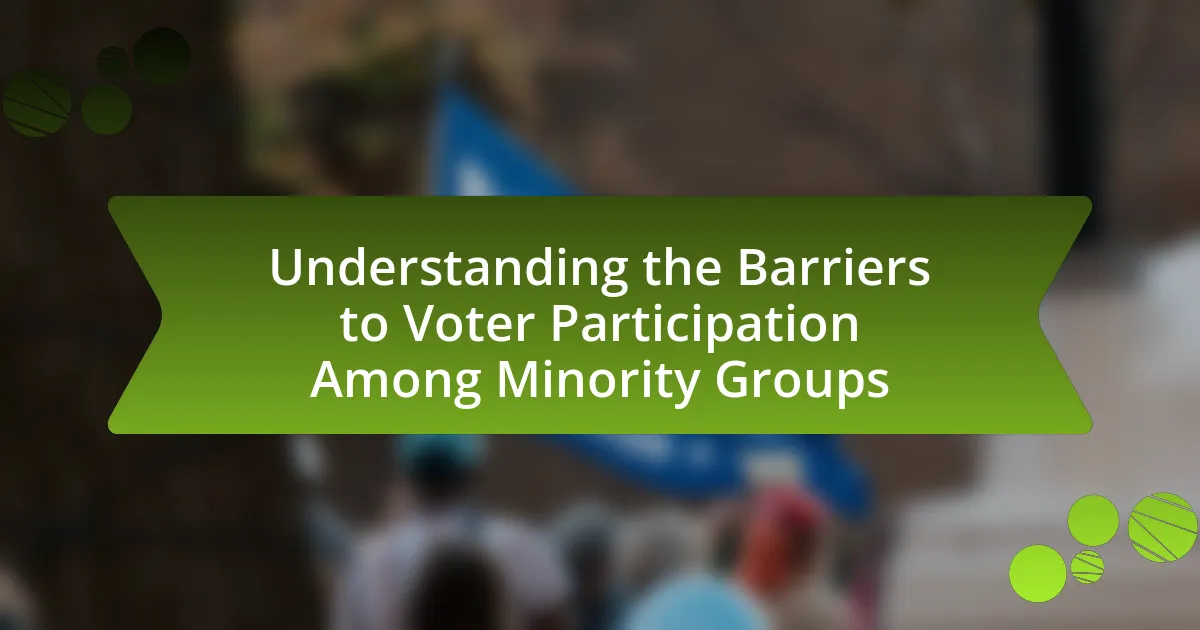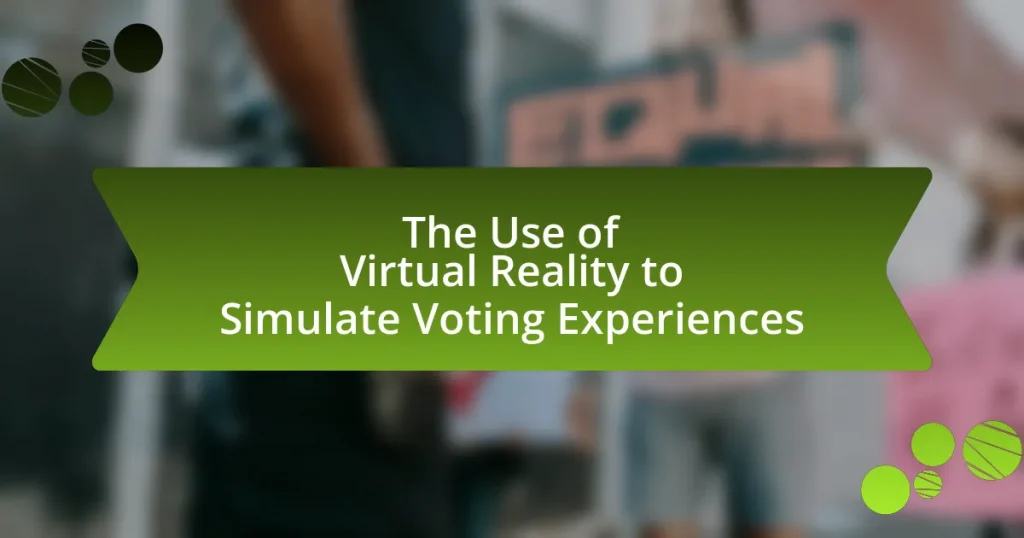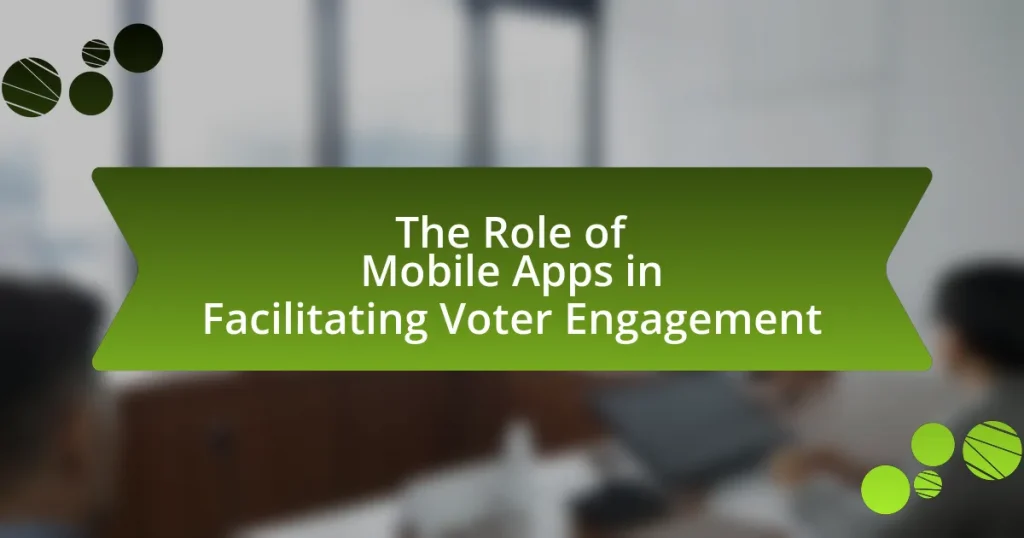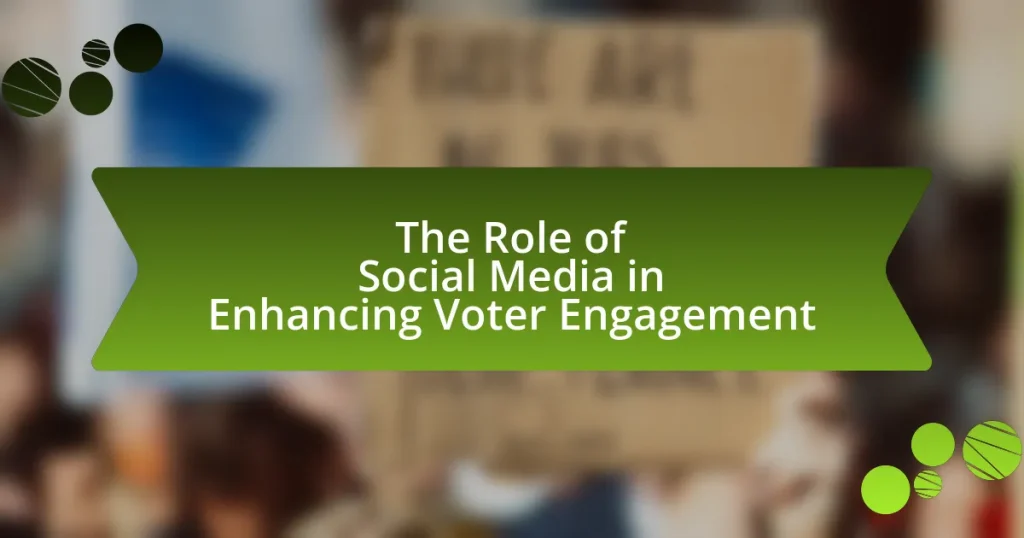The article focuses on understanding the barriers to voter participation among minority groups, highlighting systemic disenfranchisement, access to polling places, and socioeconomic challenges as primary obstacles. It examines how factors such as income level, education, and voter ID legislation disproportionately affect minority voters, leading to lower turnout rates. Additionally, the article discusses the psychological and cultural factors contributing to voter apathy, the role of community engagement in motivating participation, and potential solutions to enhance voter access and education. Overall, it provides a comprehensive analysis of the multifaceted issues impacting electoral engagement within minority communities.
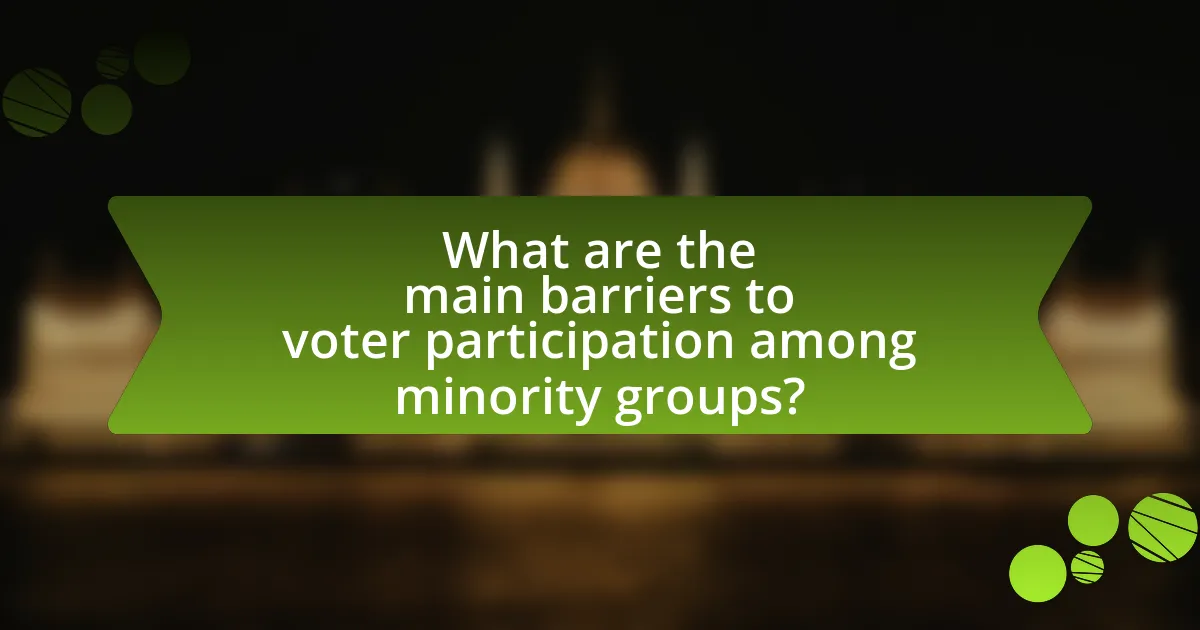
What are the main barriers to voter participation among minority groups?
The main barriers to voter participation among minority groups include systemic disenfranchisement, lack of access to polling places, and socioeconomic challenges. Systemic disenfranchisement often manifests through voter ID laws and purging of voter rolls, disproportionately affecting minorities. For instance, a study by the Brennan Center for Justice found that states with strict voter ID laws saw a significant drop in minority voter turnout. Additionally, lack of access to polling places, particularly in urban areas where many minorities reside, creates logistical challenges, as evidenced by the U.S. Census Bureau reporting that minority communities often have fewer polling locations. Socioeconomic challenges, such as lower income levels and higher unemployment rates, further hinder participation, as individuals may prioritize work or face transportation issues on election day.
How do socioeconomic factors influence voter turnout in minority communities?
Socioeconomic factors significantly influence voter turnout in minority communities by affecting access to resources, education, and civic engagement opportunities. Lower income levels often correlate with reduced access to transportation, information about the voting process, and time off work to vote, which can hinder participation. For instance, a study by the U.S. Census Bureau in 2020 indicated that individuals in households earning less than $30,000 had a turnout rate of only 43%, compared to 76% for those earning over $100,000. Additionally, educational attainment plays a crucial role; individuals with higher education levels are more likely to vote, as evidenced by research from the Pew Research Center, which found that 62% of college graduates voted in the 2020 election compared to 38% of those without a high school diploma. These socioeconomic disparities create barriers that disproportionately affect minority communities, leading to lower voter turnout rates.
What role does income level play in voter participation?
Income level significantly influences voter participation, with higher income individuals typically exhibiting greater electoral engagement. Studies indicate that individuals with higher incomes are more likely to vote due to factors such as increased access to resources, education, and civic engagement opportunities. For instance, the U.S. Census Bureau reported that in the 2020 presidential election, 79% of voters with a household income above $100,000 participated, compared to only 54% of those earning less than $30,000. This disparity highlights how economic status can create barriers to participation, particularly among minority groups who often face systemic challenges that limit their income and, consequently, their voting rates.
How does education affect the likelihood of voting among minorities?
Education significantly increases the likelihood of voting among minorities. Research indicates that higher levels of education correlate with greater political engagement and voter turnout. For instance, a study by the U.S. Census Bureau found that in the 2020 election, 76% of individuals with a bachelor’s degree voted, compared to only 50% of those without a high school diploma. This trend is particularly pronounced among minority groups, where educational attainment can empower individuals with the knowledge and resources necessary to navigate the voting process effectively. Additionally, education fosters civic skills and awareness, which are crucial for understanding the importance of participation in elections.
What impact does voter ID legislation have on minority voters?
Voter ID legislation disproportionately impacts minority voters by creating additional barriers to voting. Studies indicate that such laws can lead to lower voter turnout among these groups, as they often face challenges in obtaining the required identification. For instance, a 2014 study by the Brennan Center for Justice found that states with strict voter ID laws saw a decline in turnout among African American voters by 5 to 10 percentage points compared to states without such laws. This evidence highlights how voter ID requirements can exacerbate existing inequalities in electoral participation among minority populations.
How do strict ID requirements disproportionately affect minority groups?
Strict ID requirements disproportionately affect minority groups by creating barriers that limit their access to voting. Research indicates that minority populations, including African Americans and Hispanics, are less likely to possess the required forms of identification due to socioeconomic factors, such as lower income levels and reduced access to resources. For instance, a study by the Brennan Center for Justice found that 25% of eligible voters in these groups lack government-issued IDs, compared to only 8% of white voters. This discrepancy leads to lower voter turnout among minorities, as they face additional challenges in obtaining IDs, such as transportation issues and financial constraints. Consequently, strict ID laws exacerbate existing inequalities in the electoral process, further marginalizing these communities.
What are the arguments for and against voter ID laws?
Arguments for voter ID laws include the assertion that they enhance election security by preventing voter fraud, which some studies suggest, such as a 2014 report by the National Commission on Election Administration, indicates that voter impersonation is a rare occurrence but can undermine public confidence in the electoral process. Proponents argue that requiring identification ensures that only eligible voters participate, thereby maintaining the integrity of elections.
Conversely, arguments against voter ID laws highlight that they disproportionately affect minority groups, the elderly, and low-income individuals who may lack the required forms of identification. Research from the Brennan Center for Justice indicates that such laws can lead to disenfranchisement, as an estimated 11% of eligible voters do not possess government-issued ID. Critics argue that the laws create unnecessary barriers to voting without addressing the actual incidence of voter fraud, which is statistically minimal.
How does access to polling places affect minority voter turnout?
Access to polling places significantly affects minority voter turnout, as limited access can lead to decreased participation in elections. Research indicates that minority communities often face barriers such as long distances to polling locations, inadequate transportation options, and fewer polling places, which can discourage voting. For instance, a study by the U.S. Government Accountability Office found that minority voters are more likely to experience longer wait times and travel distances compared to white voters, which directly correlates with lower turnout rates. Additionally, the 2016 U.S. Census Bureau report highlighted that areas with fewer polling places disproportionately affect minority populations, resulting in a decline in voter engagement. Thus, improving access to polling places is crucial for enhancing minority voter turnout.
What challenges do minority communities face in accessing polling locations?
Minority communities face significant challenges in accessing polling locations, primarily due to geographic, economic, and systemic barriers. Geographic barriers include the limited number of polling places in minority neighborhoods, which can lead to long travel distances and wait times. Economic factors, such as lack of transportation and flexible work hours, further hinder access, as many individuals may not have the means to reach polling sites or may be unable to take time off work to vote. Systemic barriers, including voter ID laws and language access issues, disproportionately affect minority voters, complicating the voting process. According to the U.S. Census Bureau, in 2020, 25% of Black and Hispanic voters reported difficulties in accessing polling places, highlighting the ongoing disparities in voter participation among these groups.
How does transportation availability influence voter participation?
Transportation availability significantly influences voter participation by affecting individuals’ ability to reach polling places. When reliable transportation options are limited, potential voters may face challenges in accessing voting locations, leading to decreased turnout. For instance, studies have shown that communities with inadequate public transportation systems experience lower voter participation rates, particularly among minority groups who may rely more heavily on public transit. According to a report by the U.S. Department of Transportation, areas with high poverty rates often lack sufficient transportation infrastructure, which correlates with lower electoral engagement. Thus, the availability of transportation directly impacts the likelihood of individuals casting their votes.
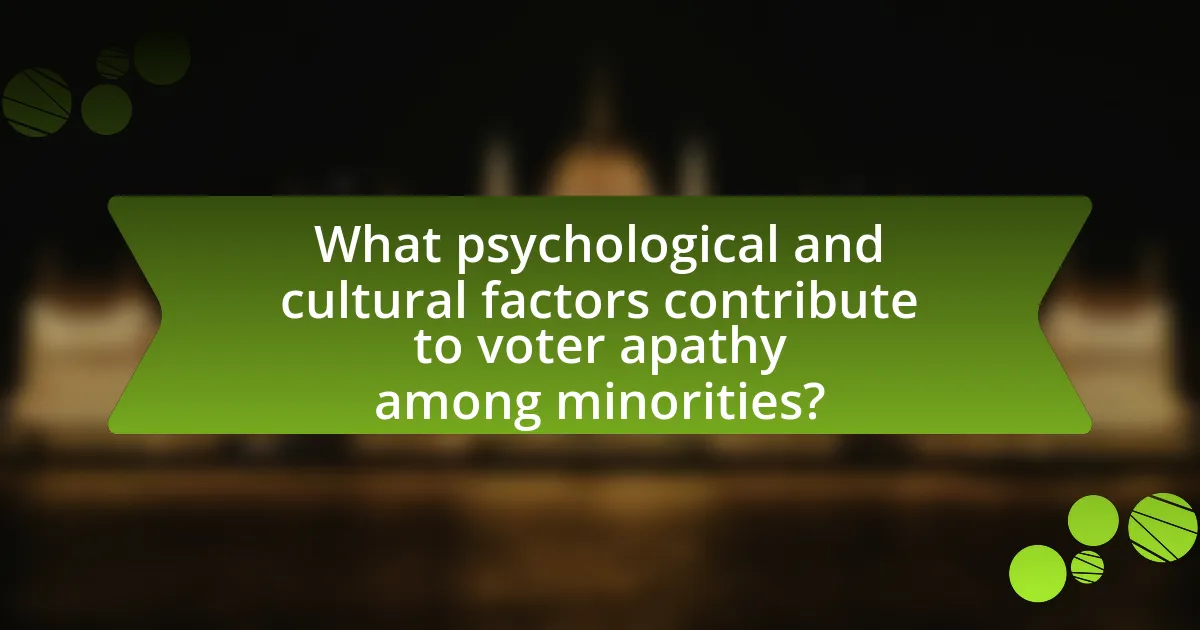
What psychological and cultural factors contribute to voter apathy among minorities?
Psychological and cultural factors contributing to voter apathy among minorities include feelings of disenfranchisement, lack of trust in the political system, and cultural disconnection from mainstream political narratives. Disenfranchisement arises from historical and systemic inequalities, leading minorities to believe their votes do not matter, as evidenced by studies showing lower voter turnout rates among these groups compared to their white counterparts. Additionally, a lack of trust in political institutions, often stemming from experiences of discrimination and marginalization, further discourages engagement; for instance, a 2018 Pew Research Center study found that only 36% of Black Americans expressed confidence in the federal government to act in their best interests. Cultural disconnection occurs when political messages do not resonate with minority communities, resulting in a perception that political processes are irrelevant to their lives. These factors collectively create a significant barrier to voter participation among minorities.
How does historical disenfranchisement affect current voting behavior?
Historical disenfranchisement significantly impacts current voting behavior by creating lasting distrust in the electoral system among marginalized communities. This distrust stems from historical injustices, such as Jim Crow laws and voter suppression tactics, which have led to lower voter turnout rates among affected groups. For instance, research by the Pew Research Center indicates that African American voter turnout was 12 percentage points lower than that of white voters in the 2016 election, reflecting the lingering effects of disenfranchisement. Additionally, studies show that individuals from historically disenfranchised backgrounds often feel alienated from political processes, leading to apathy and disengagement in contemporary elections.
What are the long-term effects of past voting suppression on minority communities?
The long-term effects of past voting suppression on minority communities include decreased political representation, diminished civic engagement, and ongoing socioeconomic disparities. Historical instances of voting suppression, such as literacy tests and poll taxes, have led to a legacy of disenfranchisement that persists today, resulting in lower voter turnout rates among minority populations. For example, the U.S. Census Bureau reported that in the 2020 election, Black and Hispanic voters faced significant barriers, contributing to a turnout gap compared to white voters. This lack of representation in political offices perpetuates policies that may not address the needs of these communities, further entrenching socioeconomic inequalities. Additionally, the psychological impact of disenfranchisement can lead to apathy and distrust in the political system, making it challenging for future generations to engage in civic activities.
How does mistrust in the political system impact voter engagement?
Mistrust in the political system significantly decreases voter engagement. When individuals perceive the political system as corrupt or unresponsive, they are less likely to participate in elections, as evidenced by studies showing that low trust correlates with lower voter turnout rates. For instance, a 2020 study by the Pew Research Center found that 61% of Americans who expressed distrust in government reported being less likely to vote, highlighting a direct relationship between mistrust and disengagement. This trend is particularly pronounced among minority groups, who may feel further alienated by systemic inequities, leading to even lower participation rates in the electoral process.
What role does community engagement play in motivating minority voters?
Community engagement plays a crucial role in motivating minority voters by fostering a sense of belonging and empowerment. When minority communities actively participate in local initiatives, they develop stronger connections to the political process, which can lead to increased voter turnout. Research indicates that grassroots organizing and community-led efforts, such as voter registration drives and informational workshops, significantly enhance political awareness and mobilization among minority populations. For instance, a study by the Pew Research Center found that communities with high levels of civic engagement saw a 20% increase in voter participation during elections. This demonstrates that effective community engagement strategies can directly influence the motivation of minority voters to participate in the electoral process.
How can grassroots organizations influence voter turnout?
Grassroots organizations can influence voter turnout by mobilizing communities, providing education on voting processes, and addressing specific barriers faced by minority groups. These organizations often engage in door-to-door canvassing, which has been shown to increase voter participation by 7% to 10% in targeted demographics, according to research from the National Bureau of Economic Research. Additionally, grassroots efforts often include organizing events that raise awareness about the importance of voting and offering resources such as transportation to polling places, which directly addresses logistical barriers that minority groups may encounter. By fostering a sense of community and empowerment, grassroots organizations effectively enhance voter engagement and turnout among underrepresented populations.
What strategies have been effective in mobilizing minority voters?
Effective strategies for mobilizing minority voters include targeted outreach, community engagement, and leveraging technology. Targeted outreach involves identifying specific minority communities and tailoring messages that resonate with their unique experiences and needs, as evidenced by the success of organizations like the NAACP in increasing voter turnout through culturally relevant campaigns. Community engagement fosters trust and encourages participation by involving local leaders and organizations, which has been shown to enhance voter mobilization efforts, particularly in the 2020 election where grassroots initiatives played a crucial role. Additionally, leveraging technology, such as social media and mobile apps, has proven effective in reaching younger voters and facilitating voter registration, as demonstrated by initiatives like Rock the Vote, which successfully registered millions of young voters through digital platforms.
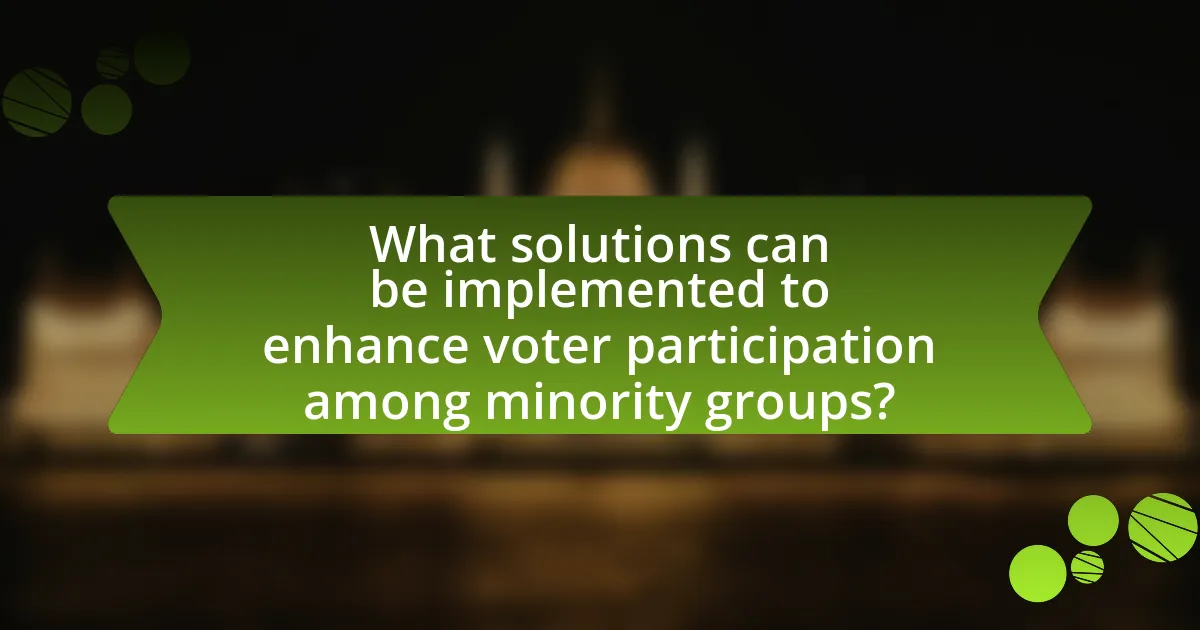
What solutions can be implemented to enhance voter participation among minority groups?
To enhance voter participation among minority groups, implementing targeted outreach programs is essential. These programs can include multilingual voter education campaigns that address specific cultural and linguistic needs, ensuring that minority communities understand the voting process and their rights. Research indicates that states with comprehensive voter outreach initiatives, such as California’s “Vote by Mail” program, have seen increased participation rates among minority voters. Additionally, providing transportation assistance to polling places can remove logistical barriers, as studies show that lack of transportation is a significant obstacle for many minority voters. Engaging community leaders and organizations to facilitate discussions and mobilize voters can further strengthen participation efforts, as evidenced by successful initiatives in cities like Atlanta, where local organizations have effectively increased turnout through grassroots efforts.
How can policy changes improve access to voting for minorities?
Policy changes can improve access to voting for minorities by implementing measures such as automatic voter registration, extended voting hours, and the establishment of more polling places in minority communities. These changes address systemic barriers that disproportionately affect minority voters, such as logistical challenges and lack of information. For instance, states that have adopted automatic voter registration have seen increases in voter registration rates among minority populations, as evidenced by a report from the Brennan Center for Justice, which found that states with such policies experienced a 10% increase in registration among eligible voters. Additionally, extending voting hours and increasing polling locations can reduce wait times and make it easier for minorities, who may face work or transportation challenges, to cast their ballots.
What reforms are necessary to make voter registration more accessible?
To make voter registration more accessible, reforms should include automatic voter registration, same-day registration, and online registration options. Automatic voter registration can increase participation by automatically enrolling eligible citizens when they interact with government agencies, as seen in states like California, which reported a 20% increase in registrations. Same-day registration allows individuals to register and vote on the same day, significantly boosting turnout; for example, states with this policy have seen turnout rates increase by up to 10%. Additionally, implementing user-friendly online registration systems can cater to younger voters and those with mobility challenges, as evidenced by a study from the Pew Research Center indicating that online registration can increase registration rates by 25%.
How can election day be made more accommodating for minority voters?
Election day can be made more accommodating for minority voters by implementing measures such as extending polling hours, providing multilingual ballots, and ensuring accessible polling locations. Extending polling hours allows individuals with varying work schedules to participate, while multilingual ballots cater to non-English speakers, enhancing understanding and accessibility. Additionally, ensuring polling locations are physically accessible for individuals with disabilities addresses barriers that minority voters may face. Research from the U.S. Census Bureau indicates that minority groups often experience higher rates of disenfranchisement, highlighting the need for these accommodations to promote equitable voter participation.
What role does education play in increasing voter participation?
Education significantly increases voter participation by enhancing individuals’ understanding of the electoral process and their civic responsibilities. Research indicates that higher levels of education correlate with increased likelihood of voting; for instance, the U.S. Census Bureau reported that in the 2020 election, 79% of college graduates voted compared to only 53% of those with a high school diploma. This knowledge empowers individuals to engage in political discussions, recognize the importance of their vote, and navigate the voting process effectively. Furthermore, educational programs that focus on civic engagement have been shown to motivate underrepresented groups, thereby addressing barriers to participation among minority populations.
How can civic education programs be tailored to engage minority communities?
Civic education programs can be tailored to engage minority communities by incorporating culturally relevant content and utilizing community-based approaches. These programs should reflect the unique histories, values, and experiences of minority groups, ensuring that the material resonates with their specific contexts. For instance, research indicates that programs that include local leaders and utilize familiar community spaces significantly enhance participation rates among minority populations. Additionally, interactive methods such as workshops and discussions can foster a sense of belonging and encourage active involvement. Studies show that when minority communities see their own narratives and leaders represented in civic education, they are more likely to engage in the electoral process.
What initiatives have proven successful in raising awareness about voting rights?
Successful initiatives in raising awareness about voting rights include the “Vote.org” campaign, which has effectively increased voter registration and participation through online resources and educational outreach. This initiative has registered over 7 million voters since its inception in 2010, demonstrating its impact on voter engagement. Additionally, the “League of Women Voters” has conducted nonpartisan voter education programs, reaching millions through community events and informational materials, thereby enhancing public understanding of voting rights and processes. These initiatives have proven effective by providing accessible information and mobilizing communities to participate in the electoral process.
What practical steps can individuals take to support minority voter participation?
Individuals can support minority voter participation by actively engaging in voter registration drives and providing information about the voting process. For instance, organizing community events that facilitate registration can significantly increase participation rates; studies show that targeted outreach in minority communities can lead to a 10-20% increase in voter registration. Additionally, individuals can volunteer with organizations that focus on educating minority voters about their rights and the voting process, which is crucial given that misinformation can deter participation. Research indicates that informed voters are more likely to engage in elections, highlighting the importance of accessible information.
